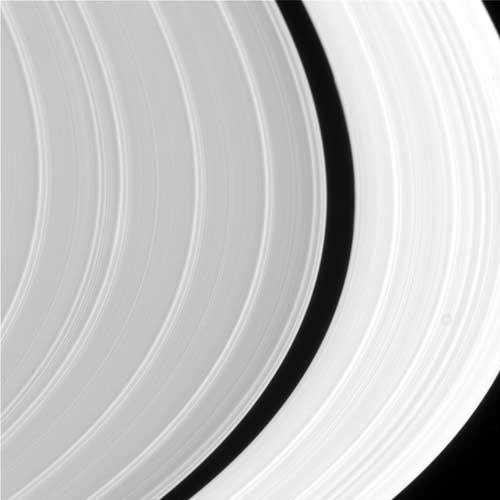Next move: Titan this weekend

The international Cassini-Huygens mission to Saturn sent the first close-up image of Saturn's rings to Earth. The spacecraft successfully entered orbit around Saturn in the early hours of Thursday morning.
NASA officials ordered the spacecraft to run its engines for 95 minutes Thursday to slow down and capture the sixth planet's gravity.
The spacecraft traveled for six years and traveled over 3 billion kilometers to reach Saturn. It was kind of threading the needle, but what we saw was the result of the work of many people and everything worked as planned, said Bob Mitchell, Cassini program manager.
"Tears came to my eyes. It's all beautiful," said Cassini's imaging team manager, Carolyn Porco, who viewed the first images. Dr. Procco said she sees regular patterns in the rings called compression waves caused by the gravitational influence of Saturn's moons. She explains that the moons affect the rings like pebbles falling into water.
The American-European spacecraft will now begin a 4-year study of the star of the rings and its 31 known moons. In the control center at the Jet Propulsion Laboratory in California there were cheers and applause when confirmation was received that Cassini was on the right track.
The spacecraft had to be programmed to perform a series of maneuvers, pointing its nose to shield it from the particles as it passed through the rings, pointing the engine forward and firing, then turning around once to observe the rings again. The tracking data for the last ignition arrived about a minute earlier than expected.
The spacecraft is in good condition
All the while the scientists and engineers of the control room had to monitor the event in a time gap. The vast distance to Saturn means that signals take more than 80 minutes to reach Earth. These 80 minutes were nerve-racking. If the planned sequence of operations had failed, Cassini could have been thrown out of the solar system by Saturn's gravity.
"We've been clawing our way through time, but what we've seen has been the result of a lot of people's work and all the investment paid off perfectly," said Bob Mitchell, Cassini's program manager.
"There was not one thing that could have been asked to be done differently that could have been done better." said.
Jerry Jones, Cassini's chief navigator, reported that the spacecraft performed the maneuvers smoothly. "The duration of the circuit according to the current route is 116.3 days. said. "We aimed for 117.4 so we are fine in that respect. According to the plan, a cleaning maneuver should be carried out on Saturday, but it is likely that we will cancel it because we are in good shape." said.
David Southwood, the European Space Agency's science director, praised his American colleagues for making a perfect entry into orbit. "This is a global mission - mainly the US and Europe working together," he said. "However, I must say that this is the evening of the Americans. Thank you USA. Thanks NASA.
Cassini-Huygens - the main spacecraft carrying the small Huygens spacecraft is supposed to land it on Saturn's largest moon, Titan. The spacecraft itself is the first man-made object to orbit Saturn and not just pass by it.
The scientists hope that the mission will provide important data about the question of how the planets were formed. They hope to learn more about Saturn's composition - its atmosphere, punctuated by giant storms, the planet's molten heart and the mysterious rings, which are known to be the remains of crashed comets, asteroids and moons.
Cassini's instruments will measure magnetic fields and radio waves, charged particles, cosmic dust, infrared and ultraviolet light. There are also wide-angle and narrow-angle cameras.
In December, Cassini will release Huygens to Titan, the only moon in the solar system that has a compressed atmosphere. Cassini is scheduled to fly by Titan about 36 hours after entering orbit and will give scientists a better look at this unknown world before Huygens is released onto it.
